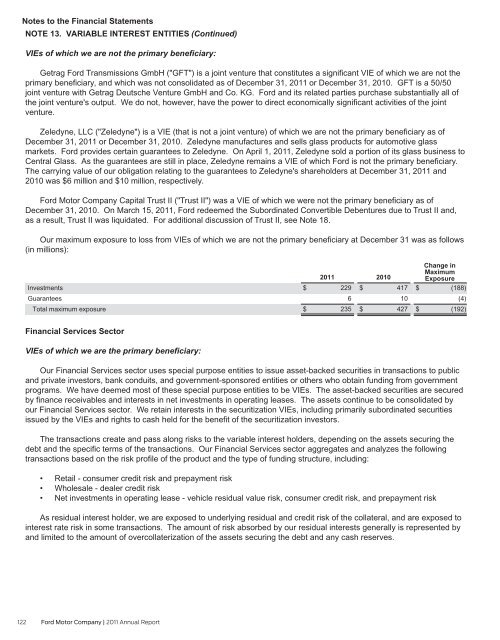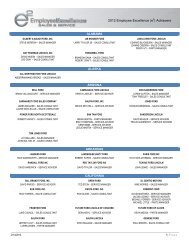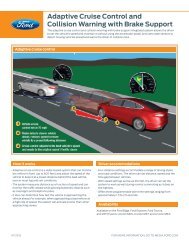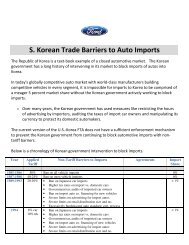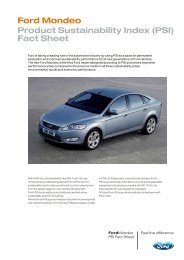Annual Report 2011 - Ford Motor Company
Annual Report 2011 - Ford Motor Company
Annual Report 2011 - Ford Motor Company
You also want an ePaper? Increase the reach of your titles
YUMPU automatically turns print PDFs into web optimized ePapers that Google loves.
Notes to the Financial Statements<br />
NOTE 13. VARIABLE INTEREST ENTITIES (Continued)<br />
VIEs of which we are not the primary beneficiary:<br />
Getrag <strong>Ford</strong> Transmissions GmbH ("GFT") is a joint venture that constitutes a significant VIE of which we are not the<br />
primary beneficiary, and which was not consolidated as of December 31, <strong>2011</strong> or December 31, 2010. GFT is a 50/50<br />
joint venture with Getrag Deutsche Venture GmbH and Co. KG. <strong>Ford</strong> and its related parties purchase substantially all of<br />
the joint venture's output. We do not, however, have the power to direct economically significant activities of the joint<br />
venture.<br />
Zeledyne, LLC ("Zeledyne") is a VIE (that is not a joint venture) of which we are not the primary beneficiary as of<br />
December 31, <strong>2011</strong> or December 31, 2010. Zeledyne manufactures and sells glass products for automotive glass<br />
markets. <strong>Ford</strong> provides certain guarantees to Zeledyne. On April 1, <strong>2011</strong>, Zeledyne sold a portion of its glass business to<br />
Central Glass. As the guarantees are still in place, Zeledyne remains a VIE of which <strong>Ford</strong> is not the primary beneficiary.<br />
The carrying value of our obligation relating to the guarantees to Zeledyne's shareholders at December 31, <strong>2011</strong> and<br />
2010 was $6 million and $10 million, respectively.<br />
<strong>Ford</strong> <strong>Motor</strong> <strong>Company</strong> Capital Trust II ("Trust II") was a VIE of which we were not the primary beneficiary as of<br />
December 31, 2010. On March 15, <strong>2011</strong>, <strong>Ford</strong> redeemed the Subordinated Convertible Debentures due to Trust II and,<br />
as a result, Trust II was liquidated. For additional discussion of Trust II, see Note 18.<br />
Our maximum exposure to loss from VIEs of which we are not the primary beneficiary at December 31 was as follows<br />
(in millions):<br />
Investments<br />
Guarantees<br />
Total maximum exposure<br />
Financial Services Sector<br />
VIEs of which we are the primary beneficiary:<br />
122 <strong>Ford</strong> <strong>Motor</strong> <strong>Company</strong> | <strong>2011</strong> <strong>Annual</strong> <strong>Report</strong><br />
<strong>2011</strong><br />
$ 229<br />
6<br />
$ 235<br />
2010<br />
$ 417<br />
10<br />
$ 427<br />
Change in<br />
Maximum<br />
Exposure<br />
$ (188)<br />
(4)<br />
$ (192)<br />
Our Financial Services sector uses special purpose entities to issue asset-backed securities in transactions to public<br />
and private investors, bank conduits, and government-sponsored entities or others who obtain funding from government<br />
programs. We have deemed most of these special purpose entities to be VIEs. The asset-backed securities are secured<br />
by finance receivables and interests in net investments in operating leases. The assets continue to be consolidated by<br />
our Financial Services sector. We retain interests in the securitization VIEs, including primarily subordinated securities<br />
issued by the VIEs and rights to cash held for the benefit of the securitization investors.<br />
The transactions create and pass along risks to the variable interest holders, depending on the assets securing the<br />
debt and the specific terms of the transactions. Our Financial Services sector aggregates and analyzes the following<br />
transactions based on the risk profile of the product and the type of funding structure, including:<br />
• Retail - consumer credit risk and prepayment risk<br />
• Wholesale - dealer credit risk<br />
• Net investments in operating lease - vehicle residual value risk, consumer credit risk, and prepayment risk<br />
As residual interest holder, we are exposed to underlying residual and credit risk of the collateral, and are exposed to<br />
interest rate risk in some transactions. The amount of risk absorbed by our residual interests generally is represented by<br />
and limited to the amount of overcollaterization of the assets securing the debt and any cash reserves.


